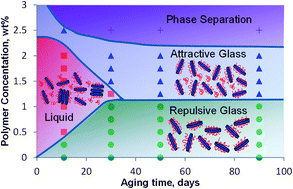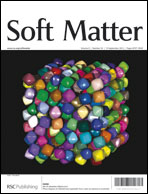A re-entrant colloidal glass transition has been observed in dispersions of a model disk shaped colloid, laponite®, with the addition of an adsorbing low molecular weight polymer, poly(ethylene oxide) (PEO). In basic solutions laponite® forms a repulsive colloidal glass. With the addition of low molecular weight PEO, we observe a retardation in formation of the glass, and the system behaves as a viscous fluid. Upon aging, a glassy phase re-forms, with the time scale depending on the concentration of polymer. For samples with polymer concentration high enough to saturate the laponite® surface, we believe this arrested state to be an attractive glass where excess PEO chains in the suspension lead to a weak interparticle attraction. For the polymer molecular weight we considered, all the samples eventually age to form a disordered state. We combine our results with previous work on laponite®–PEO dispersions to propose qualitative state diagrams with attractive glass, repulsive glass, liquid and gel regimes as a function of polymer molecular weight, polymer concentration, and aging time. To our knowledge, the progression of repulsive glass–liquid–attractive glass states has not been previously observed in colloids with adsorbing polymers.

You have access to this article
 Please wait while we load your content...
Something went wrong. Try again?
Please wait while we load your content...
Something went wrong. Try again?


 Please wait while we load your content...
Please wait while we load your content...